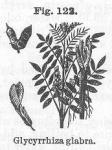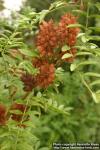Glycyrrhiza (U. S. P.)—Glycyrrhiza.

 Preparations: Solution of Extract of Glycyrrhiza
- Compound Mixture of Glycyrrhiza
- Extract of Glycyrrhiza
- Fluid Extract of Glycyrrhiza
- Pure Extract of Glycyrrhiza
- Compound Powder of Glycyrrhiza
- Syrup of Glycyrrhiza
- Compound Troches of Liquorice
- Troches of Glycyrrhiza and Opium
- Compound Fluid Extract of Sarsaparilla
- Compound Decoction of Sarsaparilla
Preparations: Solution of Extract of Glycyrrhiza
- Compound Mixture of Glycyrrhiza
- Extract of Glycyrrhiza
- Fluid Extract of Glycyrrhiza
- Pure Extract of Glycyrrhiza
- Compound Powder of Glycyrrhiza
- Syrup of Glycyrrhiza
- Compound Troches of Liquorice
- Troches of Glycyrrhiza and Opium
- Compound Fluid Extract of Sarsaparilla
- Compound Decoction of Sarsaparilla
Related entry: Ammoniated Glycyrrhizin
"The root of Glycyrrhiza glabra, Linné, and of the variety glandulifera (Waldstein et Kittaibel) Regel et Herder" (U. S. P.) (Liquiritia officinalis, Moench).
Nat. Ord.—Leguminosae.
COMMON NAMES: Liquorice-root, Spanish licorice-root, Licorice-root, Radix glycyrrhizae hispanicae.
ILLUSTRATION: Bentley and Trimen, Med. Plants, 74.
Botanical Source.—The liquorice-plant has a perennial, cylindrical root, running to a considerable length and depth, grayish-brown externally, yellow internally, succulent, tough, flexible, rapid in growth, and provided with scattered fibers. The stems are erect, herbaceous, smooth, striated, with few branches, of a dull, glaucous-gray color, growing 2 or 3 feet in height. The leaves are alternate and unequally pinnate; the leaflets generally about 13, oval, entire, obtuse, slightly emarginate, viscid, and 1 terminal; the stipules are inconspicuous. The flowers are small, bluish or purplish, in axillary, erect spikes, shorter than the leaves, and borne on long peduncles. Calyx persistent, tubular, bilabiate, and 5-cleft. The corolla is a straight, ovate-lanceolate vexillum; the keel is biparted, acute and straight. Stamens diadelphous; anthers simple and rounded; style filiform; and stigma blunt. The legumes are oblong, compressed, 1-celled, and 1 to 4-seeded; the seeds are small and reniform (L.—Wi.).
The variety glandulifera differs in not being smooth like the preceding, but in partaking more or less of a pubescent character, the leaves (beneath) and stem being glandular-pubescent, while the pods are glandular and prickly.
History.—This plant inhabits southern Europe, and some parts of Asia, and is cultivated in England, Germany, France, and in the United States to some extent. The so-called Russian liquorice (that produced by the variety glandulifera) grows from Hungary and Turkey into western Asia. Liquorice root is imported chiefly from Spain and Sicily. Commercially considered there are 5 grades, viz.: Italian, the best and sweetest, Spanish or Common liquorice root, Syrian, Turkish and Russian, the bitterest. These grades are preferred in the order named.
Description.—"In long, cylindrical pieces, from 5 to 25 Mm. (⅕ to 1 inch) thick, longitudinally wrinkled, externally grayish-brown, warty; internally tawny-yellow; pliable, tough; fracture coarsely fibrous; bark rather thick; wood porous, but dense, in narrow wedges; medullary rays linear; taste sweet, somewhat acrid. The underground stem, which is often present, has the same appearance, but contains a thin pith. The drug derived from the variety glandulifera (so-called Russian liquorice) consists usually of roots and root-branches, 1 to 4 Cm. (⅖ to 1 inch) thick, 15 to 30 Cm. (6 to 12 inches) long, frequently deprived of the corky layer, the wood rather soft, and usually more or less cleft"—(U. S. P.). Liquorice root has a faint odor and is so dense as to sink in water. It must be kept in a dry place. Those roots are to be preferred which are not worm-eaten or decayed, and whose surfaces of fracture are bright yellow.
Chemical Composition.—The characteristic constituent of the root is glycyrrhizin, so named by Robiquet (1809) on account of its sweet taste. There are furthermore present, fatty and resinous matter (0.8 per cent), small amounts of gum, albuminous substances, tannin, starch, yellow coloring matter, a bitter principle (glycyramarin), and asparagin (Plisson, 1828), a substance already recognized by Robiquet, who named it agédoïte. Sestini (1878) found from 2 to 4 per cent of this principle present in liquorice root.
Glycyrrhizin was obtained by Gorup-Besanez by making a cold infusion of the root, and heating the solution to boiling, filtering, evaporating to a smaller bulk, and precipitating with sulphuric acid. The yellow flakes thus obtained are washed with water and further purified by means of ether-alcohol (Husemann and Hilger). Z. Roussin (1875) and Habermann (1879) showed that the sweet principle, glycyrrhizin, is the acid ammonium salt of a peculiar nitrogenous tri-basic acid, called glycyrrhizic acid (often termed glycyrrhizin), to which Habermann assigned the formula C44H63NO18. The acid potassium salt of this acid is remarkable for its intensely sweet taste. The free acid, prepared from the lead salt, forms a brown, gelatinous mass, soluble in hot water, and having a bittersweet taste and acid reaction. It decomposes carbonates, swells up in cold water, is easily soluble in glacial acetic acid, but not in alcohol or ether.
Habermann (1880) found that by boiling with diluted sulphuric acid, it splits into glycyrretin (C32H47NO4), a white, tasteless powder, insoluble in water, alkali and ether, soluble in alcohol; and parasaccharic acid (C6H10O8), which reduces Fehling's solution. Gorup-Besanez believed that dextrose was formed in this reaction. Habermann obtained the acid ammonium glycyrrhizinate (glycyrrhizin proper) by crystallizing the commercial liquorice extract from glacial acetic acid, and subsequent recrystallization. In the purest state it forms yellow crystals of sweet taste, little soluble in cold water. When dissolved in hot water and then cooled, a stiff jelly is formed. This salt is hardly soluble in alcohol or ether. The amount of glycyrrhizic acid contained in liquorice root is varying. Sestini (1878) obtained 3.3 per cent from air-dried root; H. J. Möller, in 1880, obtained 7.5 per cent from Russian root (Flückiger, 1891). Mr. L. McCullough (Amer. Jour. Pharm., 1890, p. 389), found 7.18 percent. In commercial liquorice extract glycyrrhizin was found by Kremel (Archiv der Pharm., 1889, p. 511) to vary from 5.8 to 11.9 percent. Peltz (Pharm. Zschr. f. Russland, 1876, p. 257) records the results of 10 analyses of commercial extracts of liquorice root. Glycyrrhizin was found to vary from 1.33 to 18.14 per cent, starch from 1.33 to 35 per cent. Sestini (1878) found water, 48.7; glycyrrhizin, 3.27; carbohydrates, 29.62; asparagin, 1.25; ash, 2.08. (For methods of valuation of commercial liquorice extracts, see Flückiger, Pharmacognosie, 3d ed., 1891, and Alfred Mellor, Amer. Jour. Pharm., 1898, p. 136.) Glycyrrhizin is stated (Flückiger) to occur in other plants, e.g., Abrus precatorius (Berzelius), Astragalus glycyphyllos, Polypodium vulgare (Guignet, 1885), Myrrhis odorata (Schroeder, 1885), Gulielma speciosa, Martius, and Monesin bark (Peckolt, Pharm. Rundschau, 1888, pp. 31, 203, 206), but these statements, according to Flückiger, require verification.
Action, Medical Uses, and Dosage.—Liquorice root is emollient, demulcent, and nutritive. It acts upon mucous surfaces, lessening irritation, and is consequently useful in coughs, catarrhs, irritation of the urinary organs, and pain of the intestines in diarrhoea. It is commonly administered in decoction, sometimes alone, at other times with the addition of other agents, and which is the preferable mode of using it. As a general rule, the acrid bark should be removed previous to forming a decoction. When boiled for some time the water becomes impregnated with its acrid resin; hence, in preparing a decoction for the purpose of sweetening diet drinks, or covering the taste of nauseous drugs, it should not be boiled over 5 minutes. The efficiency of the root in old bronchial affections may be due to this acrid resin. The powdered root is also employed to give the proper solidity to pills, and to prevent their adhesion; the extract for imparting the proper viscidity to them. The extract, in the form of lozenge, held in the mouth until it has dissolved, is a very popular and efficient remedy in coughs and pectoral affections. An excellent troche or lozenge, very useful in ordinary cough, may be made by combining together 6 parts of refined liquorice, 2 parts of benzoic acid, 4 parts of pulverized alum, and ½ a part of pulverized opium. Dissolve the liquorice in water, and evaporate to the proper consistence, then add the powders with a few drops of oil of anise, and divide it into 3 or 6-grain lozenges. The bitterness of quinine, quassia, aloes, and the acrid taste of senega, guaiacum, mezereon and ammonium chloride are masked by liquorice.
Related Species.—Glycyrrhiza lepidota, which grows in Missouri, possesses the taste of liquorice to a considerable degree. McCullough (Amer. Jour. Pharm., 1890, p. 389) found it to contain over 6 (6.39) per cent of glycyrrhizin.
Ononis spinosa, Linné, Rest-harrow.—Europe, in sandy situations. The root of this plant is about 2 feet in length, and from less than ½ to nearly 1 inch in thickness. It is tough, curved, or twisted, and flattened, deeply rugose, and covered with a thin, deep grayish-brown bark. It is whitish internally. This has a mucilaginous taste, at first sweetish, then bitter and disagreeable, and on the whole somewhat resembles that of liquorice root. Reinsch (1842) obtained therefrom crystals of ononin (C30H34O13), tasteless and colorless, and recognized by Hlasiwetz (1855) to be a glucosid. Another constituent, ononid (C18H22O8, Hlasiwetz), discovered by Reinsch, much resembles glycyrrhizin in its chemical behavior. Hlasiwetz also isolated from Reinsch's impure ononin a waxy substance which he called onocerin. This body was recently found by H. Thoms (Archiv. der Pharm., 1897, p. 28) to be a secondary alcohol (C26H42[OH]2), for which he proposes the altered name onocol. It seems closely related to phytosterin (vegetable cholesterin).Aqueous or acetous decoctions of this root are reputed diuretic and lithontriptic, other properties also being ascribed to it. Its principal use is as a diuretic for dropsy, for which it is a popular remedy in France. Other conditions in which it has been employed are as a wash for ulcers, toothache, hemorrhoids, scalp eruptions, hydrocele, enlarged glands, and internally in jaundice, gout, and rheumatism, usually combined, in the two latter diseases, with renal depurants. The decoction is made with from 1 to 2 ounces of ononis root to water, 1 pint, the dose of which is a wineglassful several times a day. From 3 to 5 grains of ononin produced a prolonged irritation and sense of rawness in the mouth and throat (Schroff).

